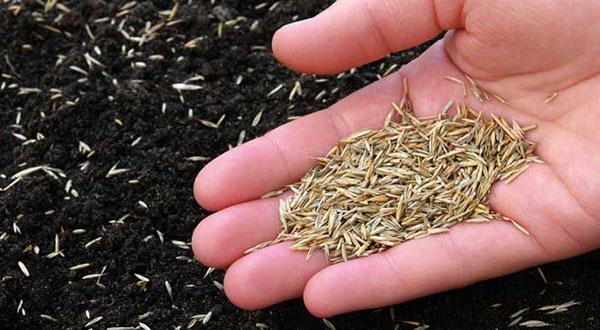Sowing a lawn by hand without weeds is not easy, but possible
 Planting a lawn with your own hands is a fairly simple process, but it will take a lot of patience to achieve optimal results. The work should be done in stages.
Planting a lawn with your own hands is a fairly simple process, but it will take a lot of patience to achieve optimal results. The work should be done in stages.
We plan a lawn
Before starting work, you should mark the area for the future lawn. It is important at the initial stage to think over the presence of other plants on the site, since in the future this can lead to difficulties with cutting the grass. If there is track, then it is worth considering the distance between the grass and curb... The distance should be up to 1 meter, for comfortable operation of the lawn mower.
Preparing the site
Substrate preparation is one of the important steps to ensure a clean and beautiful weed-free turf. Before you start sowing your lawn, you need to prepare the soil.
The main stages of land preparation:
- remove debris from the territory of the future lawn - this concerns stones, remnants of building materials, brushwood and other foreign objects;
- if there are remnants of the root system or whole unnecessary trees, they should be uprooted and removed from the site;
- herbicides are one of the options that will solve the question of how to properly sow the lawn manually without weeds;
- dig up the prepared area by fertilizing the ground;
- create a drainage layer - crushed stone or broken brick will perfectly cope with this function;
- form a flat surface, without bumps and ravines, compact the soil with a roller;
- it is necessary to enrich the soil with oxygen - to loosen the earth with a rake;
- leave the area under steam for a while.
Treat the land with herbicides. You shouldn't skimp on the quality of the drug.
Lawn Seed Selection
When choosing a lawn mix, it is important to consider the following factors:
- climatic conditions of the region;
- soil features;
- the presence of sunlight;
- functional purpose of the site.
- experts will recommend the optimal composition for your sector.
Sowing the lawn
For a good surface coverage with grass, you should carefully read the information on the package. The manufacturer indicates the required number of seeds per square meter of land. On average, 1 sq. m. will require about 30-40 gr. seeds.
Don't skimp on the amount of herb. Weeds will take over the empty spaces very quickly.
Conditionally distribute the sowing material into equal parts, this will ensure an even flow. Moisten the soil slightly by spraying water evenly.
Calm weather is an ideal day for sowing a lawn.
For an even distribution, spread the lawn grass first along and then across. Fill in the seeds with gentle, light movements and compact the soil with a roller or walk around the area. Water the area using a fine spray.
Lawn care
The area sown with grass must be systematically watered at least once a day, and more is possible. Pay particular attention to soil moisture in the first month after sowing. Further watering frequency should depend on the amount of precipitation.
It is recommended to mow the grown grass once a week.Sharp enough knives will give the grass a luscious green color, and frequent mowing will create dense grass.
After the lawn is mowed, experienced gardeners recommend watering the grass cover.
Due to the observance of simple tips, you will become the owner of a rich and dense lawn, which will become a decoration of a summer cottage or area near the house.